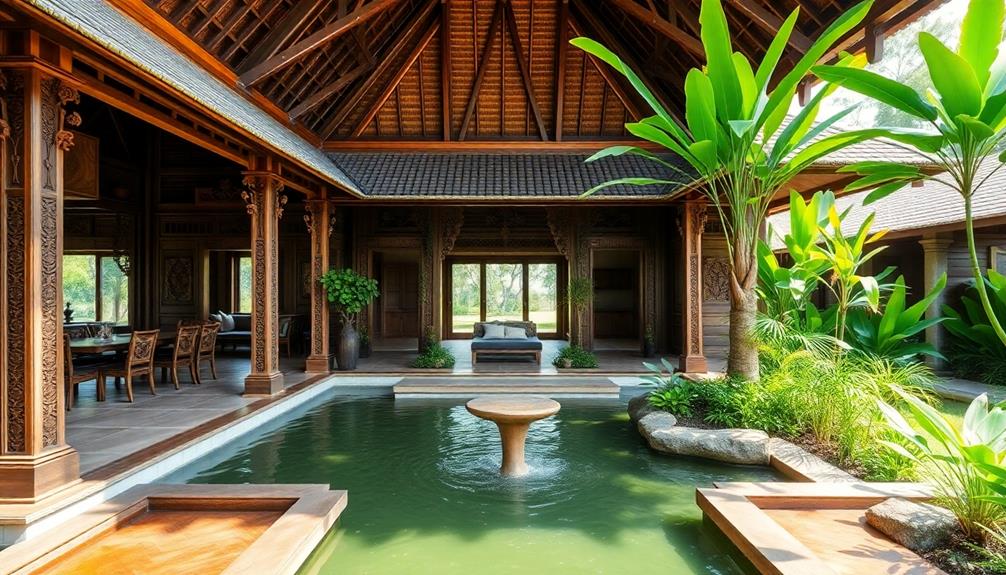Balinese architectural philosophies are essential because they weave together cultural identity and spiritual values. These designs honor interconnectedness, reflecting harmony between humans, nature, and the divine. You'll find sacred symbols embedded in each space, inviting a deeper engagement with Bali's rich traditions. The organization of architectural elements embodies a holistic approach, guiding both aesthetics and functionality. This connection to Hindu roots reinforces the island's unique narrative, making each structure a story in itself. By exploring these philosophies, you'll uncover the profound significance they hold in shaping Bali's landscape and cultural narrative.
Key Takeaways
- Balinese architectural philosophies embody sacred symbols, enriching cultural identity and reflecting spiritual beliefs within the community.
- These philosophies guide spatial organization, emphasizing harmony between humans, nature, and the divine in architectural design.
- Rituals and traditions are integrated into designs, creating energetic spaces that narrate Bali's rich spiritual heritage.
- Architectural principles like Tri Mandala and Sanga Mandala ensure balance and unity, enhancing aesthetic experiences and spiritual connections.
- Authenticity in architecture fosters belonging, connecting generations and cultivating a shared identity among the community.
Key Takeaways of Balinese Architecture

When you immerse yourself in Balinese architecture, you'll quickly realize it's more than just buildings; it's a vibrant tapestry of cultural identity and spiritual essence. Each structure embodies sacred symbols and rituals, ensuring that traditional values remain integral to the design.
You'll notice how harmonious relationships among various elements reflect deep spiritual connections, creating spaces that resonate with meaning. The spatial organization and layout honor the interconnectedness of life, showcasing a holistic approach to design.
This philosophy doesn't just shape individual buildings; it influences the entire cultural identity of Bali, enriching your experience as you explore the rich architectural landscape. Ultimately, Balinese architecture invites you to engage with its profound spiritual narrative and cultural heritage.
Significance of Architectural Philosophies
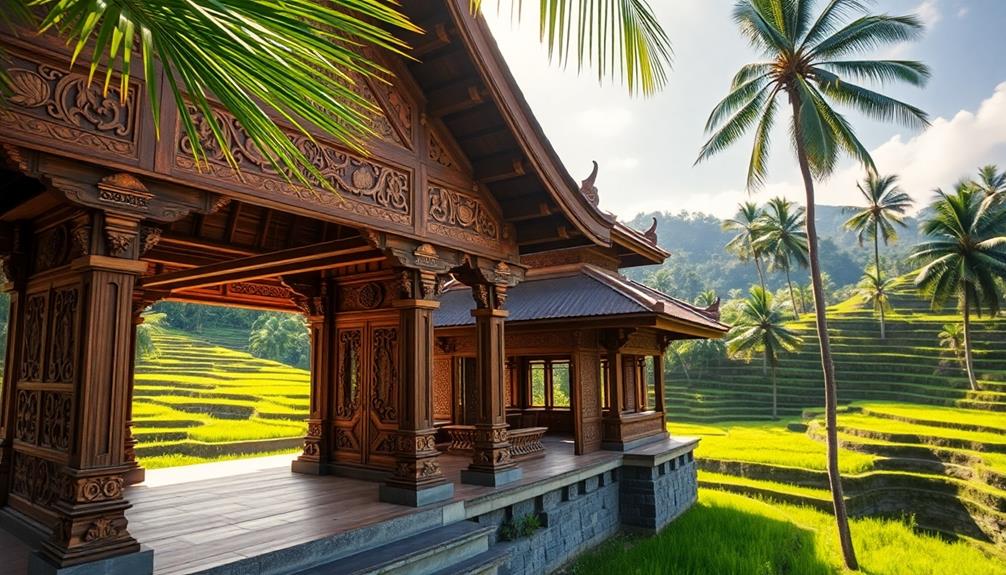
Balinese architectural philosophies play an essential role in shaping not just the structures themselves but the very essence of the culture. These philosophies guide the design and layout of buildings, reflecting core cultural beliefs and values. They serve as cornerstones for spaces that embody harmony between humans, nature, and the divine. By focusing on holistic approaches, these philosophies enrich the architectural experience and strengthen cultural identity.
| Aspect | Significance |
|---|---|
| Design & Layout | Reflects cultural beliefs and values |
| Harmony | Balances relationships among elements |
| Spiritual Essence | Shapes spaces that nourish the soul |
Hindu Roots in Architecture
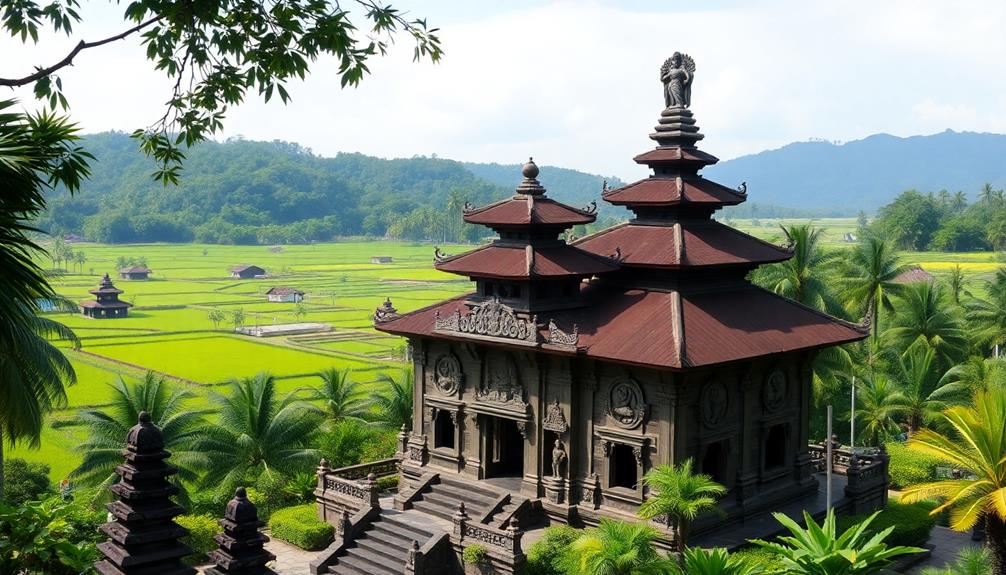
While exploring the architectural landscape of Bali, you'll discover that Hinduism plays an essential role in shaping its design principles. The influence of Hindu beliefs is evident in every corner, as sacred symbols and motifs breathe life into the structures.
You'll find that temples and shrines stand as representations of ancient traditions, embodying spiritual connections that resonate deeply with the community.
- Experience the serenity of spaces designed for divine connection.
- Feel the energy radiating from meticulously crafted sacred symbols.
- Witness the harmony in layouts that honor both nature and spirituality.
- Embrace the rich cultural tapestry woven into every architectural detail.
These elements not only reflect Bali's spiritual heritage but also invite you to engage with its profound cultural identity.
Hindu Influence on Design
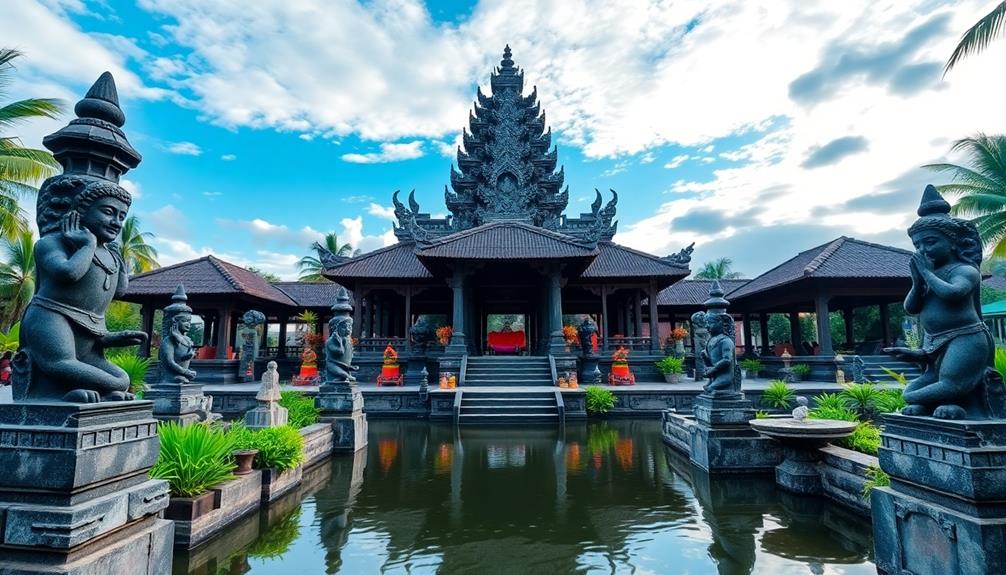
Hindu roots markedly shape the design and ornamentation of Balinese architecture, creating a unique interplay between spirituality and aesthetics.
You'll notice how religious symbolism and traditions manifest in every structure, forging a deep connection to Hindu beliefs. The layouts of these spaces often reflect Hindu rituals, emphasizing the significance of spiritual relationships.
As you explore, you'll see motifs and symbols adorning temples and shrines, which serve as focal points for expression and devotion. Each detail carries spiritual meaning, reinforcing the cultural tapestry of Bali.
This profound influence guarantees that architecture isn't just functional but also a reflection of the island's rich heritage and deep-rooted spirituality, inviting you to experience its essence.
Rituals in Architectural Design
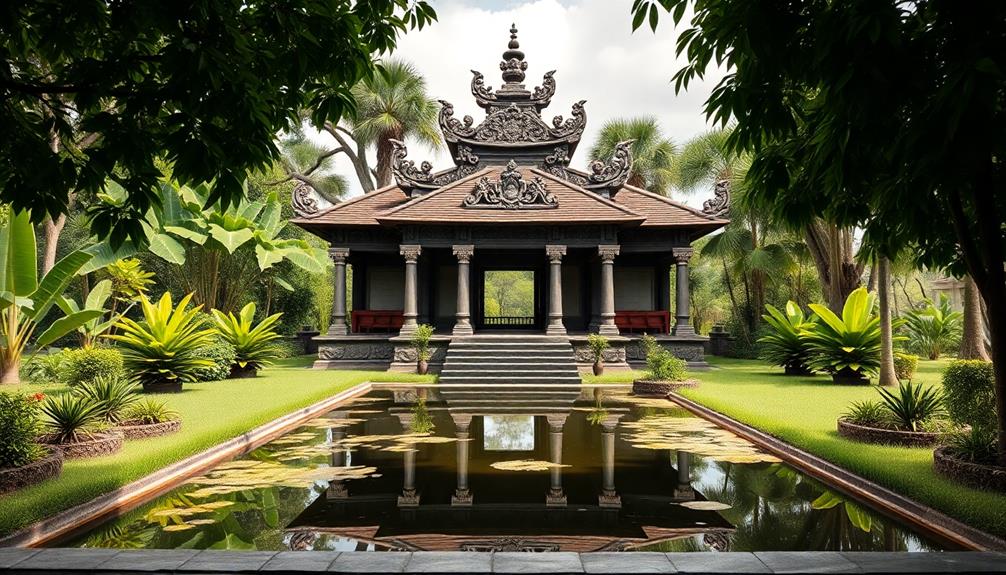
Incorporating rituals into architectural design enriches the spiritual depth of structures across Bali.
When you walk through these spaces, you’ll feel the energy emanating from the thoughtful integration of sacred practices. Each building tells a story, connecting you to the island’s rich spiritual heritage. The rituals shape not only the physical form but also the very essence of the space. As you explore further, you’ll discover hidden corners and serene altars where history and spirituality intertwine, inviting reflection and peace. This enchanting atmosphere makes the island not only a destination for nature lovers but also an island sanctuary for luxury travelers seeking a rejuvenating escape. Here, the blend of modern amenities and ancient traditions creates an unparalleled experience that nourishes both the body and soul.
- You sense the presence of ancestors and deities.
- The air is thick with intention and reverence.
- You witness the harmony between human life and nature.
- Every corner reflects a commitment to tradition and belief.
These elements transform architecture into a living reflection of Balinese culture, inviting you to experience the divine in everyday life.
Temple Design Principles
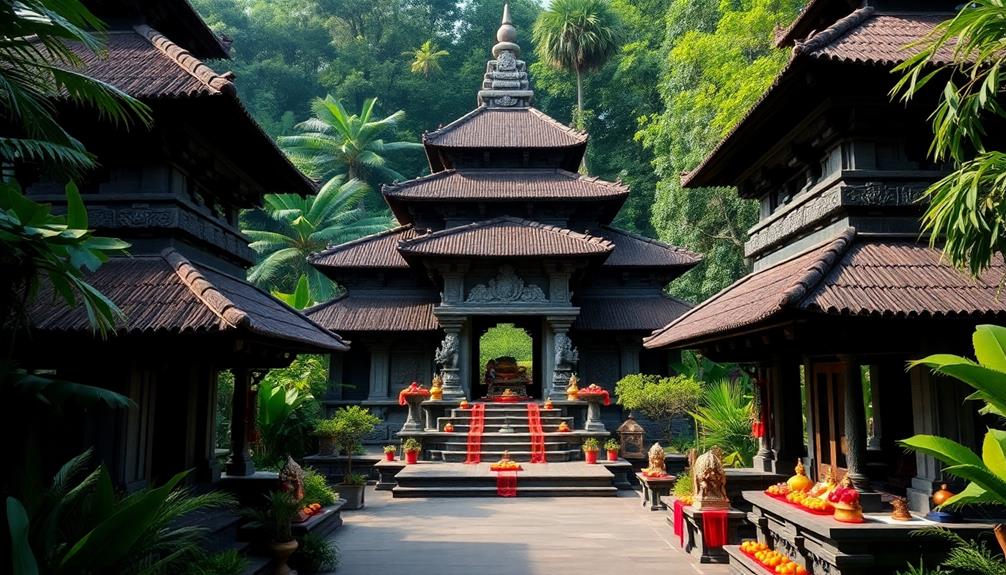
Balinese temple design principles intricately weave together spiritual beliefs and architectural elements, creating sacred spaces that resonate with reverence. You'll notice how the layout aligns with the Tri Mandala and Sanga Mandala principles, guaranteeing harmony and balance. Each temple's orientation reflects the Arga Segara concept, emphasizing a sacred axis connecting the physical to the spiritual.
| Principle | Description | Significance |
|---|---|---|
| Tri Mandala | Spatial division into three zones | Represents the cosmos and spiritual order |
| Sanga Mandala | Circular layout reflecting unity | Promotes community and collective worship |
| Asta Kosala Kosali | Guidelines for sacred measurements and elements | guarantees spiritual alignment in design |
These principles not only guide the aesthetic but also deepen the spiritual connection within each temple.
Cultural Identity and Authenticity

Architecture in Bali reflects a unique cultural identity that resonates deeply with its people. You can see this authenticity in every structure, where traditional practices merge seamlessly with spiritual essence.
Each building tells a story, fostering a sense of belonging and community. By adhering to these philosophies, you help preserve the rich heritage of Bali.
- Feel the warmth of community woven into each design.
- Experience the connection to ancestors through sacred symbols.
- Embrace the vibrant traditions that breathe life into spaces.
- Witness how architectural authenticity cultivates a shared identity.
These elements not only enhance the beauty of the landscape but also strengthen the cultural bonds that unite generations, ensuring Bali's architectural legacy endures.
Frequently Asked Questions
How Do Balinese Architectural Philosophies Impact Modern Architecture Today?
Balinese architectural philosophies inspire modern architecture by emphasizing harmony, spirituality, and cultural identity. You'll see their influence in designs that integrate natural elements, sacred symbols, and community-focused spaces, enriching contemporary architectural practices worldwide.
Are There Any Contemporary Examples of Balinese Architectural Philosophies?
Imagine a garden where ancient roots intertwine with modern blooms. You'll find contemporary Balinese architecture in eco-resorts and community centers, embracing traditional designs while fostering harmony with nature and spirituality, creating spaces that resonate with cultural identity.
What Materials Are Commonly Used in Balinese Architecture?
In Balinese architecture, you'll find materials like bamboo, volcanic stone, and teak wood. These elements reflect local resources and traditions, creating structures that blend seamlessly with nature while embodying cultural and spiritual significance.
How Do Balinese Architectural Philosophies Influence Community Planning?
Imagine walking through a village where every path whispers stories of harmony. Balinese architectural philosophies guide community planning, ensuring spaces foster connection, respect for nature, and spiritual essence, creating a vibrant tapestry of life and culture.
What Role Does Climate Play in Balinese Architectural Design?
Climate plays an essential role in Balinese architectural design. You'll notice structures incorporate natural ventilation, local materials, and rainwater management, ensuring comfort and sustainability while harmonizing with the island's tropical environment and weather patterns.
Conclusion
As you walk through the vibrant tapestry of Balinese architecture, imagine a lotus blooming in a serene pond. Each petal represents the intertwining of spirituality, community, and nature, reminding you that every structure is a sacred vessel. These philosophies shape not just buildings, but the very essence of Balinese identity. Embracing this wisdom, you too can cultivate spaces that nourish your soul, fostering harmony in your life, much like the tranquil balance found in Bali's enchanting landscapes.
